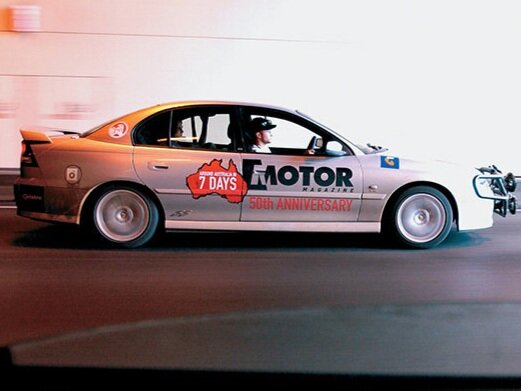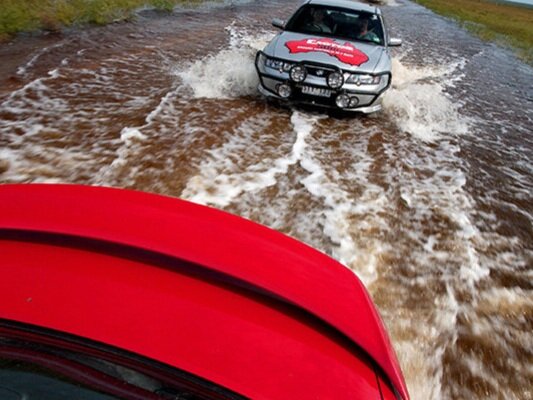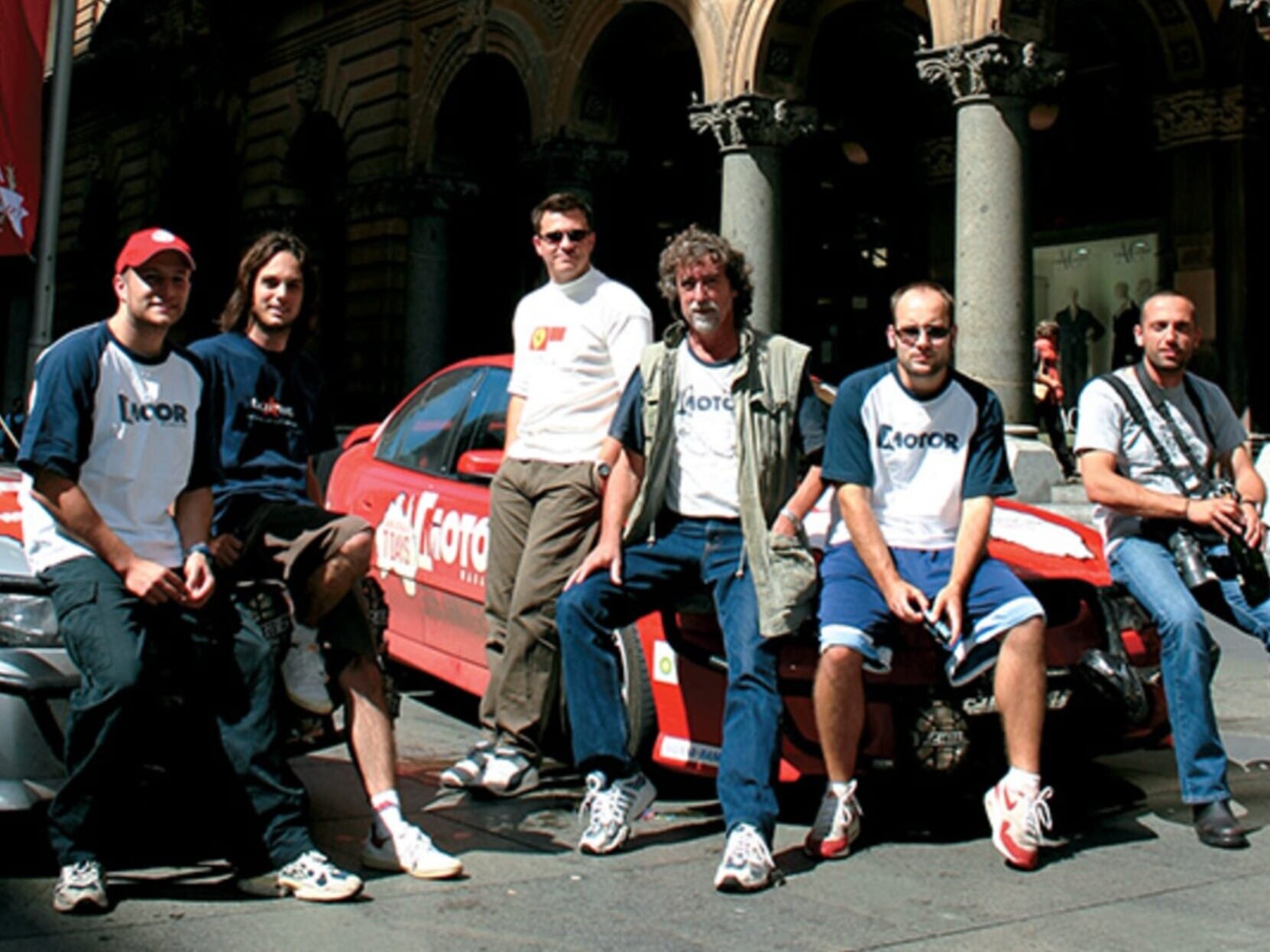Detour #102: The fastest lunatics to lap Australia
For most road trippers circumnavigating Australia would be a journey of months, maybe even years. John Mahoney did it less than a week. Non stop.
I've never been a fan of off-roading, especially the high-speed-unintentional-kind, but as we soared through the air at a little over 200km/h (120mph), at a cruising altitude of around half a metre, I had plenty of time to ponder just what part of the Australian outback's striking ochre-coloured landscape we were about to explore.
In truth, our landing was the least of our worries. It was only day three, we weren’t even halfway through an epic non-stop attempt to smash the lap record of Australia and I was already mentally and physically ruined, my co-drivers weren’t talking and the whole car reeked of the sickly-sweet smell that can only be described as gangrenous foot.
Our return to terra firm, remarkably, was pillow soft and with throttle firmly pinned, some light wheel twirling later and in just a couple of hundred metres we were back tracking dead straight. In no time the large needle was back to nudging 240km/h (150mph).
"I'll keep a better eye out for cattle grids" I promised my colleagues, as my heart continued to threaten to punch its way through my chest gravity.
"Don't worry mate, keep going, keep going. We're making excellent time", barked Paul Cockburn studying a map in the second row with a thousand-yard stare more commonly associated with war vets.
'Six days, 16 hours and 27 minutes' doesn't sound particularly fast when you say it out loud.
Well at least it didn't when I first heard it – but that's just how long it took Matt Whelon and fellow Detour contributor's Gavin Green's dad, the great Evan Green, to circumnavigate more than 15,000km (9,317 miles) of Australia's Highway 1 back in 1979 in a Ford Falcon XD.
Then you realise that time was set non-stop, with only short pauses for fuel, food and calls of nature. Worse still, it was covered on a mix of ropey highways, poorly maintained country roads and treacherous dirt, through some of the most inhospitable parts the world. It's then you begin to appreciate what an astonishing achievement that six-day record was.
But with great risk comes great rewards, as the old saying goes – and what better way to celebrate 50 years of Australia's MOTOR magazine than crushing a record that has stood for 25 years, my editor exclaimed back in 2004.
Better still, he promised, the cards were now all stacked in our favour.
The roads system had been modernised, the dirt section in the Northern Territory removed and, instead of a wheezy old XD Falcon, we had a pair of specially-prepared Holden Commodore SS, both complete with a 245kW (330bhp) 5.7-litre V8 and long-range tanks that would allow us to cover a theoretical 1,200km (746 miles) between refuels.
That explains how on March 25, 2004, at 4am we set off from the centre of Sydney under the cover of darkness to begin our eventful voyage.
Just minutes in, it was going badly wrong. The aforementioned playwright, inventor and all-round legend of Australian car journalism, Cockburn, chosen then, and only then, to sheepishly own up his night-vision isn't the best, so it would be better for him to stick to driving in the day.
Out the window figuratively and literally went the driving rota prepared meticulously by logistics expert and pro-driver Marcus 'Herman' Hoffman.
At that precise moment, as we crossed the Sydney Harbour Bridge I suffered my one and, mercifully only, short-lived bout of car sickness. All three of us wanted to pull the plug before we'd even left the city limits.
Fast-forward to day three and, apart from the crushing weariness, we felt like we were in the swing of it. What we lacked in sleep we made up for with an astonishing pace which, some 17 years later, I still can't discuss for legal reasons but let's just say it would make a Cannonballer blush.
Speed limits soon became arbitrary, except in the then limitless Northern Territory where only the wildlife curtailed our ultimate velocity.
Swapping out of of my car, nicknamed the 'Silver Bullet' to allow ace snapper Thomas Wielecki to photograph the other equally unimaginative-named 'Red Rocket', we suffered our first big brush with one of Australia's biggest hazards.
As my fellow colleague, and unhinged racer, Dean Evans wound-off some lock at an indicated 180km/h (112mph), I remember thinking how it child-like the little kangaroo fella looked as it shuffle-hopped its way to the side of the road. It even glanced both ways, I thought. And then it leapt.
Hard on the anchors, to his credit, Evans shaved a good 100km/h (60mph) off his approach but the impact was no less shocking, and still lives with me to this day.
Gone were two driving lamps and such was the force the additional bumper bar was bent back to within an inch of striking the grille. We were fortunate, Evans explains, kangaroo’s ribs are surprisingly sharp and are normally capable of puncturing the toughest radiator core.
It wasn’t just suicidal ‘roos that threw themselves in front of our car. Highway 1 cut its way through some truly mind-blowing scenery, from cityscapes to deserts, luscious tropical rainforest to regions that could double for a lunar landscape, all filled with various critters all shapes and sizes who seemed united in their desire to shuffle off this mortal coil.
These included numerous birds of prey, magpies, parrots, snakes, cute white bunnies and, even a plague of locusts of biblical proportions (who knew crushed they smell of foot rot) but the large army of cane toads that blanketed the roads in Queensland were unforgettable in the worst way –the sound of cane toads 'popping' within the wheel-arch is etched in my mind – but it's the roos, and their inherent stupidity, that 17 years later still trouble my dreams.
See one at the side of the road and beep, they leap towards you, flash your lights, they leap towards you. Slow down and try to walk around? No, they'll still hop over to you. And we're not talking about the cute little joeys, but the big muscular 2.5-metres lads who will kick you to death if they break through the screen.
That means at night, when Herman or I drove from dusk till dawn one of us kept a watchful eye and barked instructions when we spotted one lurking.
It was in Western Australia when things seriously began to go awry. A nasty tropical storm had been attacking the coast while we were edging across the Northern Territories and just as we approached Pardoo cattle station there were reports of flooding up to 400mm.
By now the madness had us in its grips. We briefly discussed pressing-on, with photographer and I volunteering to jog ahead of the cars through the water as a human depth-finder. What stopped us was our average speed dropped from 100km/h (62mph) to little more than 5km/h (3mph) thanks to the serious muscle wastage were both suffering from a lack of exercise.
Once we returned to Broome for our first decent sleep, shower and meal in days, we realised how demented our original plan was. When a cop asked how far we’d got before turning back and heard about our unique solution to judge water depth he informed us just how close we were to getting killed by the local population of crocs, who seek out the higher roads for sanctity when their holes get flooded
"Even one of them little bastards will tear your arm right out your socket,” he said.
At 7:30am, after a 14-long-hour delay, we could wait no longer and hit the road, with a car transporter in pursuit. Get too deep and he'd load the cars, for $300 a car. Cash.
In the end all we encountered was ankle-deep water and no crocs.
Progress was soon ramped-up but the absolute bleakest part of the journey was tackling the world's longest straight, the 146km-long (91-mile) Nullarbor Plain.
During the day it was tedious, at best, but at night it was nothing short of terrifying as thousands and thousands of roos amassed along the road, confusing the highway as a water source.
Trying as hard as we could, we managed to average 90-100km/h, (56-62mph) but only after swerving from left to right. More than once a roo struck the driver or passenger side but, mercifully, we made it to the South Australian border in one-piece as the odometer clicked over to reveal 12,757km (7,923 miles) in five days in the Silver Bullet . We thought the record was long gone and our mission was just to get home without going to jail for speeding.
Which explains our crawl through, what felt like, the entire state of Victoria with its zero-tolerance for speeding. It felt like agony, but the condition of the roads made rest easier to come by.
Then as we entered New South Wales the other team in the Red Rocket began driving with a sense of purpose. A quick chat on the radio and we knew why. The record was back on.
Six days, 8 hours and 52 minutes from when we first set-off we arrived back in Sydney's city centre triumphant. After 14,799km (9,192 miles) we had managed to average a mighty 97km/h (60.2 mph) despite stopping 57 times for 4,097 litres of fuel and being stranded for 14 hours.
While city workers popped out for lunch, we were celebrating with tepid champagne. A small band of half-crazed weary travellers who were, and remain, the fastest lunatics to ever lap Australia.
Words John Mahoney Twitter | Instagram
Photography Thomas Wielecki





